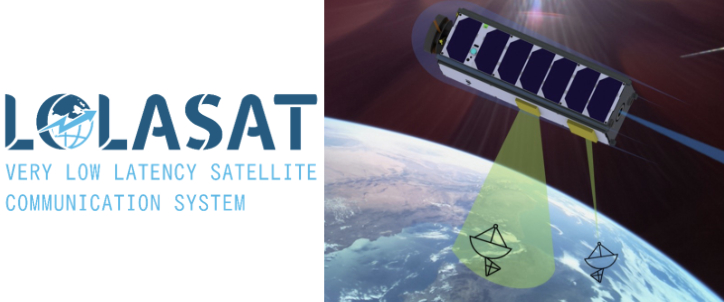LoLaSat - Very low latency satellite communication system
07.05.2023

LoLaSat is a unique mission that aims at developing and testing in orbit a very low latency satellite communication system in very low Earth orbit (VLEO) at altitudes between 200km and 300km by combining two innovative objectives.
The first objective is the usability demonstration of VLEO for satellite communication missions. One of the main drivers for decreasing the orbit altitude is the reduced link distance. This not only allows very low latencies, but also drastically reduces the required RF power transmitted from space to achieve a target Power Flux Density on ground. This enables small satellites to provide high data rate services. The mission aims at gaining operational knowledge of VLEO and thus includes the characterisation of the atmosphere density over time, experimenting with aerodynamic control, experimenting materials and characterisation of the radiation environment.
The second objective, leveraging also on the low altitude, is the demonstration of a Ka-band telecommunication payload. The project activities cover the design and manufacturing of this small communication payload based suitable to be placed on CubeSats. The activity includes six months of operations to characterise the orbital environment and test the functionality, versatility and performance of the communication link in this orbital range.
Challenges
The challenges of this mission are related to the low orbit altitude, the novelty of the involved systems and the reduced capabilities of CubeSat-Platforms. While the decreased orbit altitude allows very low signal latencies, the increased atmosphere density could lead to aerodynamic disturbances on payload pointing. The increased drag force needs to be constantly compensated by a propulsion system in order to maintain the target orbit. Furthermore, the environmental effect of atomic oxygen on the spacecraft and its antennas are not fully characterized. Moreover, development of ambitious key technologies for a satellite telecommunication system allowing terrestrial 5G applications is challenging.
Features & benefits of this mission
The system consisting of telecommunication payload, spacecraft, user equipment and TM/TC mission control on ground provides the following features:
- KA-Band communication payload with beam steering and beam forming capabilities
- signal latency of less than 10ms
- uplink rate of 10 Mbps and a downlink rate of 100 Mbps
- pattern measurement of the onboard antenna during mission operations
- propulsion system for drag compensation enabling six months of in-orbit operations at an altitude of 200 - 300km
- measurements to derive a characterisation of the gas composition in orbit and its effects on materials
- measurements to derive a characterisation of the radiation environment experienced in orbit during mission operations
- measurements of the forces experienced by the spacecraft during operations
The benefit of the final product is to enable satellite communication systems in 200 km to 300 km orbit altitudes for very low latency applications, which plays a key role in all communication networks. In a broad spectrum of user applications such as emergency support actions, safe autonomous driving of networked cars or transport drones, but also in financial services, low latency is crucial. A latency of less than 10 ms would make the perceived quality of a satellite service very similar or even better to the experience of terrestrial broadband communications. In addition, this would facilitate the integration with 5G networks. A latency of less than 10 ms could be achieved by Very Low Earth Orbit (VLEO) satellite systems operating at an altitude in the range of 200 - 300 km. The advantage of 5G telecommunication via satellite is the coverage of large areas. Traditional geostationary satellites in 36.000 km altitude exhibit the disadvantage of significant signal propagation delay due to the huge distances. LoLaSat orbits the Earth surface much closer in 200 - 300 km altitude and thus demonstrates the very low signal latency.



